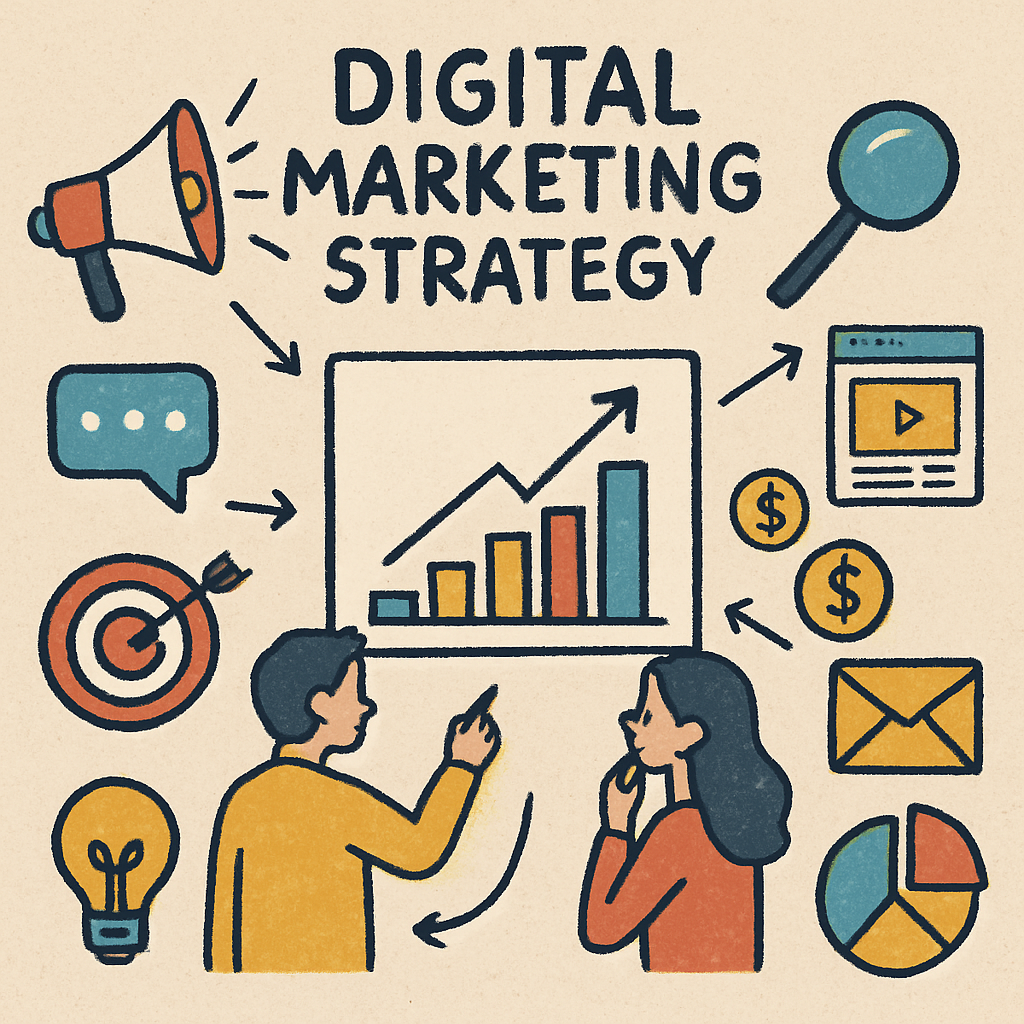
Understanding the Differences: Digital Marketing vs Branding
By comprehending the fundamental differences between digital marketing and branding, businesses can effectively harness the strengths of each. This dual approach ensures not only the immediate attraction of customers but also the cultivation of a loyal customer base. Through this article, we will delve into the core aspects of both digital marketing and branding, explore their key components, and discuss how they can be integrated for optimal results.

Digital marketing provides businesses with the tools to reach a broader audience than traditional marketing methods. It allows for targeted campaigns that speak directly to the interests and behaviours of specific consumer groups. This precision targeting not only enhances the effectiveness of marketing efforts but also increases the return on investment by ensuring that marketing dollars are spent on reaching the most receptive audiences.
Key Components of Digital Marketing
- Search Engine Optimisation (SEO): Enhancing your website’s visibility on search engines. This involves optimising content, improving website architecture, and building backlinks to ensure your site ranks highly for relevant search terms. SEO is a long-term strategy that builds organic traffic and credibility over time, crucial for establishing a strong online presence.
- Content Marketing: Creating valuable content to attract and engage your audience. This includes blogs, videos, infographics, and more. Effective content marketing not only informs and entertains but also positions your brand as an authority in your industry, fostering trust and loyalty among your audience.
- Social Media Marketing: Leveraging platforms like Facebook, Instagram, and LinkedIn to connect with your audience. This involves creating and sharing content tailored to each platform’s unique demographics and features. Social media marketing is vital for building brand awareness and fostering community engagement, turning followers into brand advocates.
- Email Marketing: Sending targeted messages to nurture leads and build customer relationships. Email marketing allows for personalised communication, delivering relevant content directly to the inboxes of your audience. It’s an effective tool for keeping your brand top-of-mind and driving conversions.
- Pay-Per-Click Advertising (PPC): Buying visits to your site through ads on search engines and social media. PPC provides immediate visibility and is a cost-effective way to drive traffic to your site. By targeting specific keywords and demographics, PPC campaigns can yield quick results and complement other digital marketing efforts.
Digital marketing is data-driven and measurable. This allows businesses to analyse their campaigns’ effectiveness and make informed decisions based on real-world results. By leveraging analytics and performance metrics, companies can fine-tune their strategies, optimise their marketing spend, and achieve better outcomes.
The Art of Branding
Branding, on the other hand, is the process of creating a distinct identity for your business. It’s about howyour audience perceives you and the emotional connection they form with your brand. Branding involves crafting a cohesive narrative that encompasses your values, mission, and aesthetics. This narrative is what differentiates your business from competitors and makes your brand memorable.
Branding is not just about visuals; it’s about the experience and emotions your brand evokes. A strong brand is built on authenticity and consistency, which fosters trust and loyalty among consumers. It’s a long-term investment that, when done right, can lead to increased brand equity and customer retention.
Core Elements of Branding
- Brand Identity: The visual aspects of your brand, including logo, colour palette, and typography. These elements should be consistently applied across all marketing materials to create a recognisable and professional image. A well-designed brand identity helps convey the essence of your business and what it stands for.
- Brand Voice: The tone and style of communication that reflects your brand’s personality. Whether your brand is formal and authoritative or casual and friendly, maintaining a consistent voice across all channels is crucial for building a cohesive brand image. This voice should resonate with your target audience and align with your brand’s values and mission.
- Brand Story: The narrative that communicates your brand’s mission and values. A compelling brand story can engage and inspire your audience, creating a deeper emotional connection with your brand. It should articulate why your brand exists and what it stands for, helping to differentiate you from competitors.
- Brand Experience: The total experience your audience has with your brand across all touchpoints. This includes customer service, product quality, and every interaction a consumer has with your brand. A positive brand experience can lead to increased customer satisfaction and loyalty, turning customers into brand advocates.
Branding is about building trust and loyalty. It’s the lasting impression that sets you apart from competitors and resonates with your audience on a deeper level. A strong brand can command premium pricing, foster customer loyalty, and withstand market fluctuations.
Digital Marketing vs Branding: The Key Differences
Purpose
- Digital Marketing: Focuses on short-term goals like increasing sales and generating leads. It’s about immediate action and conversion, driving results that can be measured in real-time. Digital marketing campaigns are designed to meet specific business objectives quickly and efficiently.
- Branding: Centres on long-term goals like building brand equity and fostering loyalty. It’s about creating a lasting relationship with your audience and ensuring your brand remains relevant and respected over time. Branding efforts are ongoing and focus on maintaining a consistent image and message.
Approach
- Digital Marketing: Tactical and often campaign-based, utilising specific channels and metrics to achieve objectives. It involves using data and analytics to optimise performance and adjust strategies for maximum impact. Digital marketing requires agility and responsiveness to changing market conditions.
- Branding: Strategic and holistic, encompassing all aspects of how your brand is perceived. It’s about aligning every aspect of your business with your brand values and ensuring consistency across all touchpoints. Branding requires a long-term vision and commitment to maintaining brand integrity.
Measurement
- Digital Marketing: Highly measurable, with analytics and KPIs to track performance. Metrics such as click-through rates, conversion rates, and return on investment provide insights into the effectiveness of campaigns. This data-driven approach allows for continuous improvement and optimisation.
- Branding: More qualitative, often measured through brand awareness and customer perception. Tools like surveys, focus groups, and social listening can help gauge brand sentiment and recognition. Branding success is reflected in customer loyalty, brand recall, and overall market position.
Integrating Digital Marketing and Branding
To achieve business success, it’s essential to integrate digital marketing and branding. Here’s how you can effectively combine the two:
Consistent Messaging
Ensure that your brand’s voice and message are consistent across all digital marketing efforts. This reinforces your brand identity and builds trust with your audience. Consistent messaging helps to create a unified brand image, making it easier for consumers to recognise and relate to your brand.
Cohesive Visuals
Your brand’s visual elements should be reflected in all digital marketing materials. This includes using the same colour schemes, fonts, and logo placement to create a seamless experience. Cohesive visuals enhance brand recognition and help convey professionalism and credibility.
Customer-Centric Approach
Both digital marketing and branding should focus on delivering value to the customer. Understand your audience’s needs and tailor your strategies to meet them. Prioritising the customer experience, you can build stronger relationships and foster loyalty.
Data-Driven Decisions
Leverage data from digital marketing campaigns to inform branding decisions. Use insights to refine your brand strategy and ensure it resonates with your target audience. Data can reveal customer preferences nd bebehaviourshelping you align your brand with consumer expectations.
Real-World Examples

Let’s look at some real-world examples to illustrate how successful companies integrate digital marketing and branding:
- Apple: Known for its sleek design and innovative technology, Apple’s branding is consistent across all marketing channels. Their digital marketing efforts emphasise product innovation and customer experience, reinforcing their brand values. Apple’s use of minimalist design and clear messaging ensures its brand is instantly recognisable and highly respected.
- Nike: Nike’s branding centres around empowerment and athleticism. Their digital marketing campaigns, such as the “Just Do It” series, align with this narrative, creating a powerful and cohesive brand message. Nike’s ability to inspire and connect with athletes and fitness enthusiasts underscores the strength of its integrated marketing approach.
- Coca-Cola: Coca-Cola’s branding is all about happiness and sharing. Their digital marketing strategies, including social media campaigns and interactive content, reflect this theme, strengthening their brand identity. Coca-Cola’s consistent focus on joyful experiences and community engagement keeps its brand at the forefront of consumer consciousness.
Conclusion
In conclusion, while digital marketing and branding serve different purposes, they are both integral to a successful marketing strategy. By understanding their differences and integrating them effectively, businesses can create a strong brand presence and achieve their objectives. Whether you’re a startup founder looking to build a standout MVP, a head of digital transformation aiming to modernise systems, or a marketing director seeking cohesive branding, understanding and leveraging both digital marketing and branding will set you on the path to success.
Remember, digital marketing drives immediate action, while branding builds lasting relationships. Together, they form a powerful combination that can propel your business to new heights. Embracing both strategies allows for a balanced approach that not only captures attention but also nurtures enduring customer loyalty.
FAQS
1. What is the difference between digital marketing and branding?
Branding shapes a company’s identity, voice, and perception. Digital marketing promotes the brand through online channels to attract and convert customers.
2. Is branding more important than digital marketing?
Branding builds recognition and trust. Digital marketing drives leads and sales. Neither replaces the other; they work best together.
3. Can a business do digital marketing without branding?
Yes, but the impact is usually weak. Without a clear brand identity, marketing campaigns feel generic and have lower conversion rates.
4. Does branding affect digital marketing performance?
Absolutely. Strong branding improves click-through rates, recall, loyalty, and overall ROI because customers recognise and trust the brand.
5. Which comes first: branding or digital marketing?
Branding should come first. You need a defined identity, tone, values, and messaging before launching campaigns.





